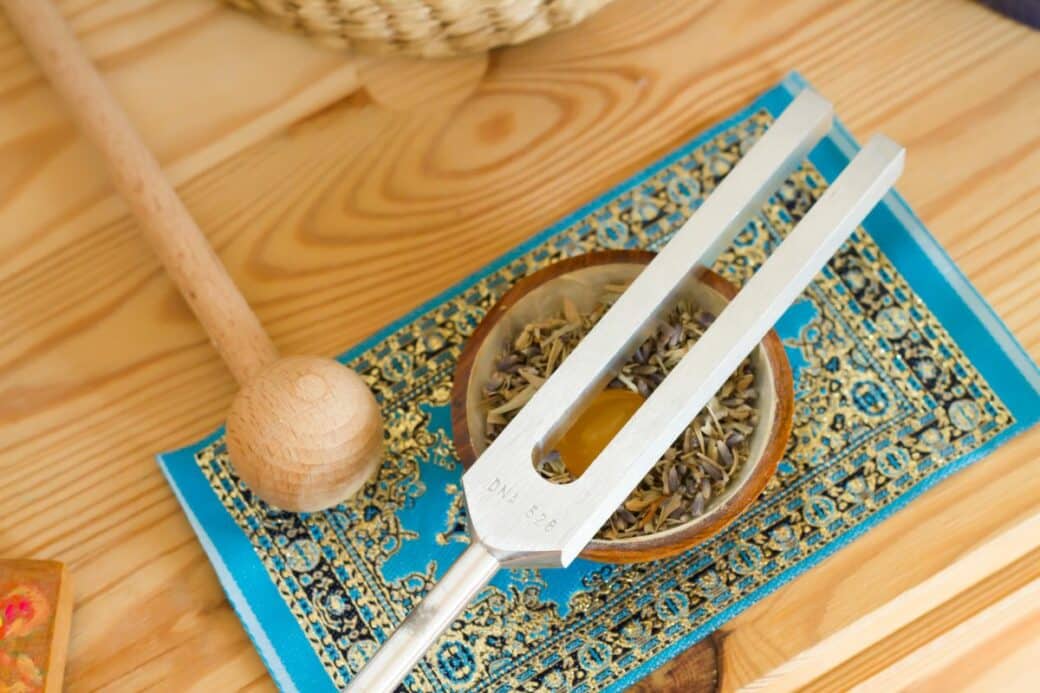When it comes to exploring the world of sound therapy, there are fascinating tools that have captivated the attention of many: the singing bowl and the tuning fork. Both of these instruments have a unique ability to create rich, resonating tones that can help promote relaxation and healing. In this article, we will compare the sounds produced by the singing bowl and the tuning fork, highlighting their distinct qualities and discussing how they can be used in various therapeutic practices. Whether you are a curious beginner or a seasoned practitioner, this article will provide valuable insights into the beautiful world of sound therapy.

Singing Bowl Vs Tuning Fork: Understanding the Basics
Defining Singing Bowls
Singing bowls, also known as Tibetan singing bowls or Himalayan singing bowls, have been used for centuries as musical instruments, meditation tools, and healing aids. These bowls are primarily made of metal and produce a unique and enchanting sound when struck or rubbed with a mallet. The shape and size of the bowl, as well as the metal composition, contribute to the quality and tone of the sound. Singing bowls have gained popularity not only for their soothing melodies but also for their potential therapeutic benefits.
Understanding Tuning Forks
Tuning forks are small, metal instruments that consist of a handle and two prongs. They are commonly used in various fields, including music, medicine, and science. When struck against a surface or activated by a tuning fork activator, tuning forks vibrate at a specific frequency, producing a pure and distinct sound. These precise frequencies allow tuning forks to be employed for tuning musical instruments, testing hearing, and even promoting relaxation and balance in alternative therapies.
Origins and Historical Background

History and Origin of Singing Bowls
The exact origins of singing bowls are shrouded in mystery, as their precise age and place of origin cannot be definitively determined. However, they are believed to have emerged in the Himalayan regions of Nepal, India, Tibet, and Bhutan thousands of years ago. Singing bowls were traditionally used by Buddhist monks in their meditation practices and religious ceremonies. Over time, their mesmerizing sound and potential healing properties captured the attention of people around the world, leading to their widespread popularity and use in various contexts.
Evolution of Tuning Forks
Tuning forks have a relatively more documented history compared to singing bowls. It is believed that the basic concept of tuning forks dates back to the 17th century when they were initially developed for musical purposes. However, their usage expanded beyond just tuning instruments and became an essential tool in the fields of physics and medicine. Over the years, the design of tuning forks has evolved to include different shapes, sizes, and materials to cater to the diverse needs and applications they serve.
How They Work: Sound Production
Sound Production in Singing Bowls
The captivating sound produced by singing bowls arises from the interaction between the mallet and the bowl itself. When a singing bowl is struck or rubbed with a mallet, it creates friction, causing the metal to vibrate. These vibrations are then transmitted through the bowl, resulting in a rich blend of harmonics and overtones. The size, shape, and thickness of the bowl, as well as the metal composition, influence the pitch and quality of the sound produced. The sound produced by singing bowls can be sustained for a prolonged duration, contributing to their therapeutic and meditative qualities.
The Science Behind Tuning Fork Sound
Tuning forks operate on the principle of acoustic resonance. When a tuning fork is struck, its prongs vibrate at a specific frequency. These vibrations create sound waves that travel through the surrounding air and are perceived as sound. The pitch of the sound is determined by the frequency at which the tuning fork vibrates, which is directly related to the length and thickness of the prongs. The precise frequency at which a tuning fork vibrates enables it to serve specific purposes, such as tuning musical instruments or testing hearing.
Materials Used
Materials for Crafting Singing Bowls
Traditionally, Tibetan singing bowls were crafted using a variety of metals, including copper, tin, zinc, iron, silver, and gold. The combination of these metals contributes to the unique sound and characteristics of each bowl. Modern singing bowls may incorporate alloys or even other materials such as crystal, which can offer different tonal qualities. The craftsmanship of singing bowls involves intricate techniques, including hand hammering and annealing, which are passed down through generations to preserve the authenticity and quality of these instruments.
Components of a Tuning Fork
Tuning forks are predominantly made of metal, with steel being a commonly used material due to its durability and resonance properties. The handle of a tuning fork is usually made of a non-vibrating material, such as aluminum or plastic, to allow for easy handling and manipulation. Some tuning forks also feature weight discs or adjustable weights on the prongs, allowing for fine-tuning and frequency adjustment. The materials used in tuning forks are carefully chosen to ensure accurate and consistent sound production.
Types and Variations
Different Types of Singing Bowls
Singing bowls come in various shapes, sizes, and styles, each offering a distinct sound experience. The most common types of singing bowls include the classic Tibetan singing bowls, which have a rounded shape and produce a deep and resonant sound. Jambati bowls, with their broader shape and wider rim, create a melodious tone with rich harmonics. Another variation is the crystal singing bowl, which is made from quartz crystal and produces a pure, ethereal sound. Each type of singing bowl provides a unique sonic experience, catering to different preferences and purposes.
Varieties of Tuning Forks
Tuning forks are available in a wide range of frequencies and designs to accommodate various applications. Musical tuning forks are often categorized based on their pitch and note, such as A440 (standard pitch) or C256 (scientific pitch). Medical tuning forks, on the other hand, are specially designed to assess hearing, balance, and neurological functions. Additionally, there are specialized tuning forks crafted for therapy and holistic healing, each tuned to specific frequencies believed to promote relaxation, balance, and emotional well-being.
Applications and Uses
Common Uses of Singing Bowls
Singing bowls have found a myriad of applications in different settings and disciplines. In spiritual practices and meditation, singing bowls are used to induce a state of deep relaxation and inner peace. Their calming tones can help reduce stress, anxiety, and even promote better sleep. Singing bowls are also valued in sound therapy sessions, where the resonant vibrations are believed to facilitate energetic healing and chakra alignment. Additionally, singing bowls have found a place in music production, sound healing practices, and home decor due to their aesthetic appeal and enchanting sound.
Where Tuning Forks Are Used
Tuning forks have extensive applications in various fields, thanks to their precise and consistent frequencies. In the realm of music, tuning forks are used to tune instruments and create harmonious ensembles. In medicine, they play a crucial role in audiology, allowing healthcare professionals to assess a person’s hearing abilities. Tuning forks are also utilized in neurological exams to test reflexes and diagnose certain conditions. Moreover, tuning forks have gained popularity in alternative therapies, where they are employed for vibrational healing, energy work, and promoting overall well-being.
Industries Impacted
Singing Bowls in the Wellness Industry
The wellness industry has significantly benefited from the rising popularity of singing bowls. With an increasing interest in holistic healing and alternative therapies, singing bowls have become integral tools in wellness practices. From yoga studios to meditation centers, these enchanting instruments help create a deeply calming and immersive environment. Sound therapists and energy healers incorporate singing bowls into their sessions to facilitate relaxation, balance the chakras, and restore harmony within the mind, body, and soul. Singing bowls have also found their way into spas and wellness retreats, enhancing the overall experience and encouraging deep relaxation.
Tuning Forks in Medical and Musical Fields
The medical and musical fields have been revolutionized by the application of tuning forks. In medicine, tuning forks are indispensable tools for assessing hearing, particularly in audiometry tests. Medical professionals rely on tuning forks to evaluate hearing loss, test bone conduction, and diagnose specific hearing disorders. In the musical realm, tuning forks are vital for tuning instruments accurately, creating harmonies, and training musicians’ ears. Online music platforms, orchestras, and music schools often utilize tuning forks to ensure precise pitch standards and create cohesive musical performances.
Therapeutic Benefits
Benefits of Singing Bowl Therapy
Singing bowl therapy, also known as sound healing, has gained significant recognition for its potential therapeutic benefits. The vibrations and resonant tones produced by singing bowls can induce a deep state of relaxation, reduce stress, and promote a sense of well-being. Sound therapy sessions with singing bowls have been reported to alleviate anxiety and improve sleep quality. The harmonious vibrations are believed to activate the body’s natural healing processes, restore balance to the energy centers (chakras), and enhance overall physical and emotional well-being.
Healing Properties of Tuning Forks
Tuning forks, often used in vibrational and energy healing practices, are believed to possess a range of healing properties. The specific frequencies emitted by tuning forks are thought to facilitate energetic balance, stimulate circulation, and promote relaxation. In addition, they can help relieve tension, pain, and even aid in emotional release. Tuning forks are often used in conjunction with acupressure points, meridians, or chakra systems to amplify their therapeutic effects. While more research is needed to validate their healing potential, tuning forks continue to be embraced by practitioners and individuals seeking alternative healing modalities.
Practical Demonstration and Instruction
How to Use a Singing Bowl
Using a singing bowl is a simple yet powerful practice that can be incorporated into your daily routine. Start by finding a quiet and comfortable space where you can focus and relax. Hold the singing bowl in the palm of your hand or place it on a soft cushion. With the mallet in your other hand, gently strike the bowl or rub the rim in a circular motion. As the bowl begins to vibrate, listen attentively to the resonant sound and feel the vibrations in your body. You can further enhance the experience by focusing on your breath or repeating a mantra. Experiment with different techniques and explore the unique soundscapes the singing bowl offers.
Utilizing a Tuning Fork Correctly
To make the most of tuning forks, it is important to understand how to use them correctly. When activating a tuning fork, hold the handle firmly and strike it against a rubber activator or the palm of your hand. Be sure to strike it with enough force to initiate vibrations, but not too forcefully to avoid damage. Once activated, hold the vibrating prongs close to your ear or place them on a specific body point for healing purposes. Experiment with different placements and observe the vibrations’ effects on your body, mind, and energy. Tune in to the subtleties of the sound and allow yourself to immerse in the healing experience tuning forks can offer.
Challenges and Limitations
Potential Downsides of Singing Bowls
While singing bowls offer numerous benefits, it is important to be aware of potential downsides. One common challenge is the quest for authenticity, as not all singing bowls on the market are authentic Tibetan or Himalayan bowls. It is essential to research and purchase from reputable sources to ensure genuine quality and craftsmanship. Additionally, some individuals may find the sound of singing bowls overwhelming or may not resonate with the vibrations. Each person’s experience can vary, so it is essential to find the right sound and technique that suits your preferences and sensitivity.
Limitations of Tuning Forks
While tuning forks have a wide range of applications, they also come with certain limitations. One limitation lies in their inability to produce complex harmonies or multiple notes simultaneously, as they generate a single tone at a time. Additionally, tuning forks may require periodic re-tuning or calibration to maintain their accuracy. Furthermore, the therapeutic benefits of tuning forks are still being explored, and more research is needed to establish their efficacy in various healing modalities. Despite these limitations, tuning forks play a valuable role in numerous fields and continue to contribute to the advancement of science, music, and medicine.
In conclusion, singing bowls and tuning forks are fascinating instruments with unique characteristics and diverse applications. Their enchanting sounds and potential therapeutic benefits have captured the attention of individuals, practitioners, and industries alike. Whether you are seeking relaxation, harmony, or a deeper connection to yourself, exploring the world of singing bowls and tuning forks can offer a rich and transformative experience. So, why not allow yourself to be enveloped in the mesmerizing vibrations and embark on a journey of sound and self-discovery?




